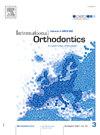Effect of post-curing parameters and material thickness on the color stability of 3D-printed dental resins: An in vitro study
IF 1.9
Q2 DENTISTRY, ORAL SURGERY & MEDICINE
引用次数: 0
Abstract
Objective
To assess the effect of variations in post-curing temperatures and times on the colour stability of 3D-printed resins used in orthodontics and paediatric dentistry applications and the effect of material thickness on colour properties was also examined.
Methods
The two different disk samples (15.00 × 1.0 mm, n = 90; 15.00 × 2.00, n = 90; diameter and height, respectively) were designed and printed from biocompatible resin with SLA technology. These samples were subjected to various post-curing temperatures and times (60 ̊C and 30 min, 60 ̊C and 90 min, 60 ̊C and 120 min, 60 ̊C and 60 min, 40 ̊C and 60 min, 80 ̊C and 60 min). The values of L*, a*, and b* of the 3D-printed resin samples were evaluated under D65 illumination conditions in the centre of the samples using a spectrophotometer. The same researcher recorded the average values after the measurements were performed three times for each sample.
Results
The results indicated significant differences in colour stability (L*, a*, b* values) among samples subjected to different post-curing conditions. Variations in post-curing time and temperature significantly affected the colour of the resins. The study found that certain post-curing conditions could lead to acceptable colour values that are similar to natural teeth.
Conclusions
The study concluded that the time and temperature of post-curing significantly affected the colour properties of 3D-printed clear resins used in orthodontic applications. It suggests that a 30-minute post-curing time can yield acceptable colour values, highlighting the importance of selecting appropriate post-curing conditions based on clinical requirements. Additionally, an increase in material thickness was found to correlate with increased yellowness in the samples.
Clinical significance
The changes in post-curing temperature and time may impact colour properties. Clinicians should consider this situation when manufacturing with 3D printing.
固化后参数和材料厚度对3d打印牙用树脂颜色稳定性影响的体外研究
目的评估固化后温度和固化时间对用于正畸和儿科牙科应用的3d打印树脂颜色稳定性的影响,并研究材料厚度对颜色特性的影响。方法两种不同椎间盘标本(15.00 × 1.0 mm, n = 90;15.00 × 2.00, n = 90;直径和高度分别为直径和高度),采用生物相容性树脂采用SLA技术设计和打印。这些样品经历了不同的后固化温度和时间(60℃和30 min、60℃和90 min、60℃和120 min、60℃和60 min、40℃和60 min、80℃和60 min)。在D65照明条件下,用分光光度计在样品中心测量3d打印树脂样品的L*、a*和b*值。同一位研究人员对每个样本进行了三次测量后,记录了平均值。结果不同后固化条件下样品的颜色稳定性(L*、a*、b*值)存在显著差异。后固化时间和温度的变化显著影响树脂的颜色。研究发现,某些固化后的条件可能会导致与天然牙齿相似的可接受的颜色值。结论:后固化时间和温度对正畸应用中3d打印透明树脂的颜色特性有显著影响。这表明30分钟后固化时间可以产生可接受的颜色值,突出了根据临床要求选择适当的后固化条件的重要性。此外,发现材料厚度的增加与样品中黄度的增加有关。临床意义固化后温度和时间的变化会影响颜色特性。临床医生在使用3D打印制造时应该考虑到这种情况。
本文章由计算机程序翻译,如有差异,请以英文原文为准。
求助全文
约1分钟内获得全文
求助全文
来源期刊

International Orthodontics
DENTISTRY, ORAL SURGERY & MEDICINE-
CiteScore
2.50
自引率
13.30%
发文量
71
审稿时长
26 days
期刊介绍:
Une revue de référence dans le domaine de orthodontie et des disciplines frontières Your reference in dentofacial orthopedics International Orthodontics adresse aux orthodontistes, aux dentistes, aux stomatologistes, aux chirurgiens maxillo-faciaux et aux plasticiens de la face, ainsi quà leurs assistant(e)s. International Orthodontics is addressed to orthodontists, dentists, stomatologists, maxillofacial surgeons and facial plastic surgeons, as well as their assistants.
 求助内容:
求助内容: 应助结果提醒方式:
应助结果提醒方式:


